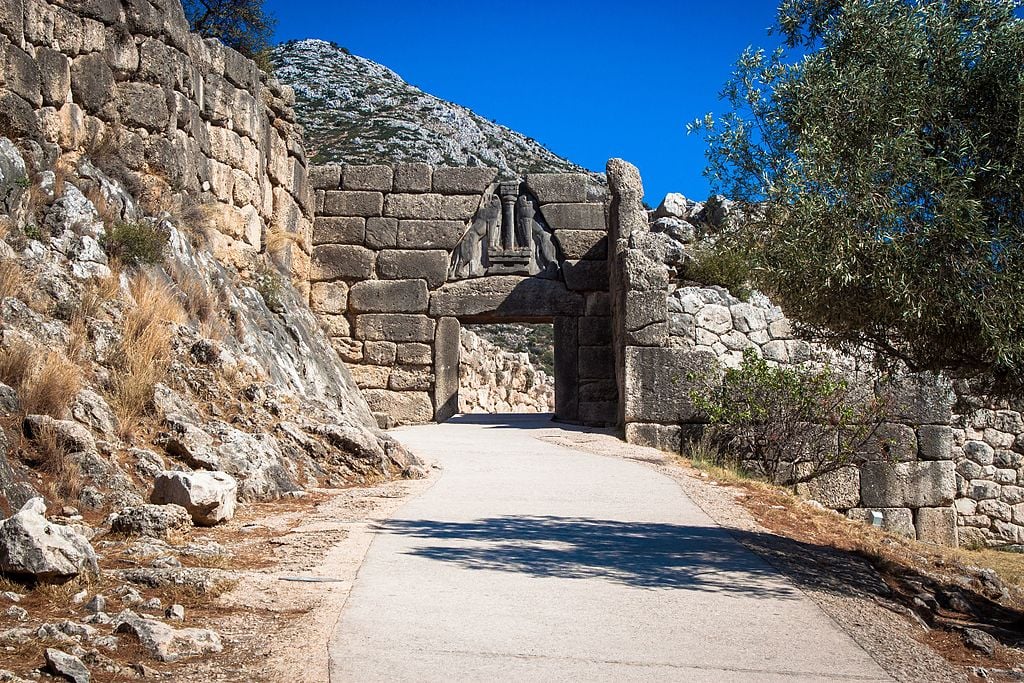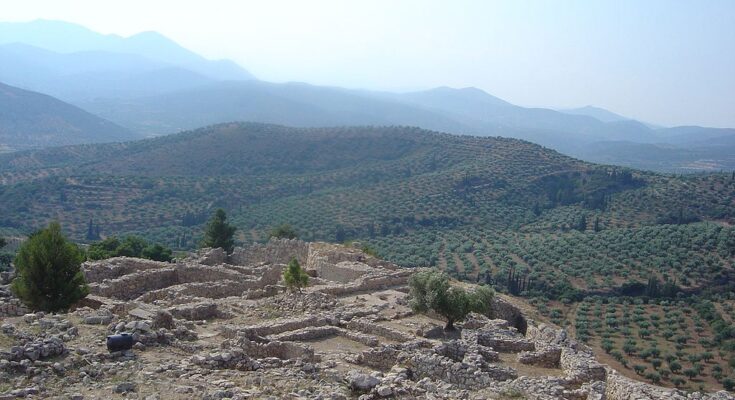The UNESCO site of Mycenae is one of the most important archaeological sites in Greece. This is the area where an early Greek civilization, called the Mycenaean civilization, first appeared during the 2nd millennium BC.
A recent video shows in resplendent detail the recreated buildings and artwork of ancient Mycenae, from the throne room atop its highest hill to the lower town, including the interplay of dolphins on frescoes in one of the buildings.
Created by Professor Nikolaos Lianos, who teaches architecture at the Democritus University of Thrace, it is based on the findings of Professor Christos Maggidis, the director of the excavations of Mycenae’s Lower Town.
A piece of stone that was recovered in the excavations is part of the original throne on which the Mycenaean rulers sat, from which they would look down on a fire that was placed in the middle of the room.
Early Greek civilization of Mycenae settled as early as 1600 BC
Mycenae in Argolis, in the northeastern Peloponnesian Peninsula, is located about 120 kilometers (75 miles) southwest of Athens; just 19 kilometers (12 miles) inland from the Saronic Gulf, the ancient city was built upon a hill rising 900 feet (274 meters) above sea level.
It was one of the major centers of Greek civilization as far back as the second millennium BC, with a military stronghold which dominated much of southern Greece, Crete, the Cyclades and even parts of southwest Anatolia.
The period of Greek history from about 1600 BC to about 1100 BC is called Mycenaean in deference to the overwhelming influence of its culture at the time. At its peak, in 1350 BC, the citadel and lower town of Mycenae had a population of 30,000.
The first identification of the location of ancient Mycenae in modern times came as the result of a survey conducted by Francesco Grimani, who was commissioned by the Provveditore Generale of the Kingdom of the Morea in 1700.
Grimani used the Ancient Greek writer Pausanias’ description of the Lion Gate to identify the ruins of Mycenae. Although the citadel was built by Greeks, the name Mukanai is thought not to be Greek but rather one of the many pre-Greek place names inherited by the immigrant Greeks.
Early and Middle Bronze Age in Ancient Mycenae
Legend has it that the name was connected to the Greek word mykēs (μύκης, or”mushroom”). This is why Pausanias ascribes the name to its legendary founder, Perseus, who was said to have named it either after the cap (mykēs) of the sheath of his sword, or after a mushroom he had plucked on the site.
Situated in the northeast corner of the Argive plain, it easily overlooked the whole area and was ideally positioned to be a centre of power, especially as it commanded all easy routes to the Isthmus of Corinth.
As elsewhere in the region, a Cretan influence prevailed in Mycenae begging around 1600 BC; the first evidence of this was the shaft graves there, which were discovered in 1876 by the amateur archaeologist who discovered Troy, Heinrich Schliemann.
Schliemann’s shaft graves, dating back to the sixteenth century BC came to be known as Circle A to distinguish them from the Circle B graves which were found at a later date.

Successive palaces built over the centuries
Ceramics spanning the entire Early Helladic age was discovered at Mycenae during 1877–78 by Panagiotis Stamatakis far down in the sixth shaft grave in Circle A. Later such material was found beneath the walls and floors of the palace, located on the summit of the acropolis, and outside the Lion Gate in the area of the ancient cemetery.
The early Greek civilization of Mycenae developed into a formidable power from 1550 to 1450 BC, and is believed to have become the main center of all Aegean civilization through the fifteenth century. The Minoan hegemony of the area came to an end around 1450; there is evidence that Knossos, the site of the once magnificent palace, was occupied by Mycenaeans until it too was destroyed in approximately 1370 BC.
At a conventional date of 1350 BC, the fortifications on the acropolis of Mycenae were rebuilt in a style known as Cyclopean because the blocks of stone used were so massive that they were thought in later ages to be the work of the one-eyed giants known as the Cyclopes.
Successive monumental palaces were built inside these city walls — much of which can thankfully still be seen today. The final palace to be built, the remains of which are still visible on the acropolis, was constructed between 1400-1300 BC
Earlier palaces must certainly have existed, but they had been cleared away or built over. The construction of palaces at that time with a similar architecture was general throughout southern Greece. They all featured a megaron, or throne room, with a raised central hearth under an opening in the roof, which was supported by four columns in a square around the hearth.
A throne was placed against the center of a wall to the side of the hearth, allowing an unobstructed view of the ruler from the entrance. Frescos adorned the plaster walls and floor.
The room was accessed from a courtyard with a columned portico. A grand staircase led from a terrace below to the courtyard on the acropolis. The largest stones, including the lintels and gate jambs, weighed well over 20 tons; some may have been close to an astonishing 100 tons.
Mycenaean expansion throughout the Aegean continued until the massive disruption of society that occurred in the first half of the twelfth century, which brought about an end to Mycenaean civilization, culminating in the destruction of Mycenae itself around 1150 BC.
The eventual destruction of Mycenae formed part of the general Bronze Age collapse in the Greek mainland and beyond. Within a short time, by 1200 BC, all the palace complexes of southern Greece were burned, including the beautiful one at Mycenae.
This is thought to have been there result of a Dorian invasion of Greeks from the north, although many historians now doubt that this invasion caused the destruction of the Mycenaean civilization.
Displaced populations escaped to former colonies of the Mycenaeans in Anatolia and elsewhere after that cataclysmic event; all the Mycenaean centers throughout Greece were destroyed almost simultaneously.
Much later, in 468 BC, troops from Argos captured Mycenae, expelling what was left of the inhabitants and razing the ancient fortifications.
Revival — and abandonment of Mycenae once again
Mycenae was briefly reoccupied during the Hellenistic period when it even boasted a new theater, which was located over the Tomb of Clytemnestra. The site was subsequently abandoned once again, however.
By the time of Roman rule in Greece, its ancient ruins had become a tourist attraction. The ancient travel writer Pausanias visited the site and briefly described the prominent fortifications and the Lion Gate, still visible in his time, in the second century AD.
Pausanias also describes being led to the site by shepherds, showing that the surrounding area was never completely abandoned.



